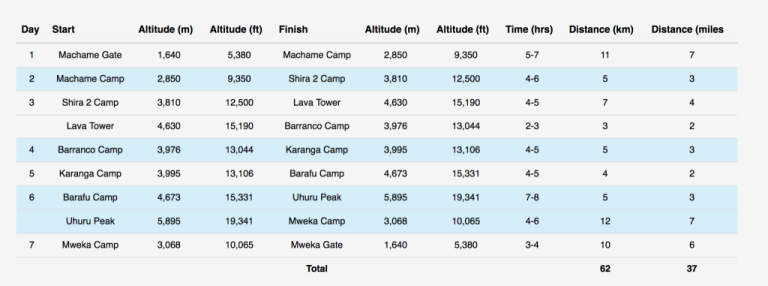MACHAME ROUTE KILIMANJARO
The most popular route to the summit of Mount Kilimanjaro these days is Machame route, and for good reason. This trail offers stunning views, a reasonable challenge, and plenty of time to acclimate, making it a good choice for those who have a bit of extra time in their schedule. Machame route has been nicknamed the “Whiskey Route” because it is often perceived as being tougher than Marangu ro, which is often referred to as the “Coca-Cola” route. Unlike that trail however, camping is allowed on Machame, which means trekkers will be sleeping in tents all the way to the summit. Trekkers who take the Machame Route pass several well known Mount Kilimanjaro landmarks while en route, including the famed Lava Tower and Shira Plateau. The route wanders up and down a series of valleys and ridges, which make the walk a bit more strenuous, but rewards hikers with some of the best views on the mountain. It is for that reason that Machame route is widely considered to be the most scenic of all of the routes up Mount Kilimanjaro, providing unique and varied landscapes to pass through on each and every day. The trail starts on the south side of the mountain, passes underneath the Southern Ice Field and makes its summit approach from the Barafu Camp.
For travelers who have a few extra days in their schedule, Machame route is an excellent option. One or two additional days of acclimatization can make a big difference in the success rate, so trekkers who choose this route reach the summit more often, despite the fact that this is a more challenging hike than Marangu route.
One of the biggest and most intimidating of those challenges is the Barranco Wall, a steep cliff face that can look quite scary upon first approach. In reality, Barranco isn’t nearly as frightening or difficult as it first appears, although you will have to watch your step, and possibly use your hands for extra leverage while scrambling over certain sections. The climb usually takes about an hour to an hour and a half to complete, and the view from the top makes it worth the effort.
The downside of the Machame Route is that it can get crowded at times. Because it is so scenic, and offers a few extra days to acclimate, it is a popular choice for Kilimanjaro trekkers, which can make the trail and campsites very busy, particularly during the high season.
Still, if you’re looking for the quintessential Kilimanjaro experience, it is difficult to beat Machame route.
Climbing Kilimanjaro offers Machame as a seven day climb or as a six day climb. The six day variation combines days four and five, going from Barranco Camp to Barafu Camp without staying at Karanga. You Skip Karanga Camp
Machame Route 7 days Itinerary Overview
Starting from Machame Gate to the summit and finish at Mweka Gate. For a day-by-day itinerary for the Machame Route please click on this link: 7 day Machame Route

Machame Route Detailed Itinerary
The itinerary below describes the 6 nights/7 day Kilimanjaro climb via the Machame route. To shorten the below itinerary to six days you skip the night in the Karanga Valley and instead walk straight from the Barranco Huts to the Barafu Huts in one day.
Starting Point: Machame Gate (1830 m/6000 ft)
Duration: 6-7 days
Day 1 - Machame Gate (1830 m/6000 ft) - Machame Huts (3030 m/9940 ft)
Walking distance: 5.5 km/3.5 miles
Walking time: 5-7 hours
Altitude gain: 1200 m/3940 ft
The drive from Moshi to the Mount Kilimanjaro National Park Gate takes about 50 minutes. The journey passes through the village of Machame which is located on the lower slopes of the mountain.
We now leave the park gate and walk through the rain forest on a winding trail up a ridge. Lower down, the trail can be muddy and slippery. Gaiters and trekking poles are a good idea here. We continue a short distance until we reach the Machame Camp.
Day 2 - Machame Huts - New Shira Camp (3850 m/12630 ft)
Walking distance: 5.5 km/3.5 miles
Walking time: 4-6 hours
Altitude gain: 820 m/2690 ft
After breakfast, we leave the glades of the rain forest and continue on an ascending path, crossing the little valley walking along a steep rocky ridge, covered with heather, until the ridge ends. The route now turns west onto a river gorge. Time for rest, dinner, and overnight at the Shira campsite.
Day 3 - New Shira Camp - via Lava Tower (4640 m/15220 ft) - Barranco Huts (3985 m/13070 ft)
Walking distance: 10 km/6.2 miles
Walking time: 5-7 hours
Altitude gain: 135 m/440 ft (790 m/2590 ft to Lava Tower)
From the Shira Plateau, we continue to the east up a ridge, passing the junction towards the peak of Kibo. As we continue, our direction changes to the South East towards the Lava Tower, called the “Shark’s Tooth.” Shortly after the tower, we come to the second junction which brings us up to the Arrow Glacier at an altitude of 16,000ft. We now continue down to the Barranco Hut at an altitude of 13,000ft. Here we rest, enjoy dinner, and overnight. Although you end the day at the same elevation as when you started, this day is very important for acclimatization and will help your body prepare for summit day.
Day 4 - Barranco Huts - Karanga Camp (4040 m/13255 ft) - Barafu Huts (4680 m/15360 ft)
Walking distance: 9KM/5.5 miles
Walking time: 8-10 hours
Altitude gain: 695 m/2280 ft
After breakfast, we leave Barranco and continue on a steep ridge passing the Barranco Wall, to the Karanga Valley campsite. Then, we leave Karanga and hit the junction which connects with the Mweka Trail. We continue up to the Barafu Hut. At this point, you have completed the South Circuit, which offers views of the summit from many different angles. Here we make camp, rest, enjoy dinner, and prepare for the summit day. The two peaks of Mawenzi and Kibo are to be seen from this position.
Day 5 Barafu Huts- Summit attempt via Stella Point (5752 m/18871 ft) to Uhuru Peak (5895 m/19340 ft) and descent via Mweka Route to Millenium Camp (3820 m/12530 ft) (or to Mweka Hut)
Walking distance: 5 km/3 miles ascent + 10 km/6.2 miles descent
Walking time: 5-6 hrs + 1-2 hours up, 5-6 hours down (the overall walking time may vary from 10 - 16 hours)
Altitude gain: 1072 m/ 3511 ft (Stella Point) or 1215 m/3980 ft (Uhuru Peak)
Descent: 2075 m/6810 ft
Very early in the morning (midnight to 2am), we continue our way to the summit between the Rebmann and Ratzel glaciers. You head in a northwesterly direction and ascend through heavy scree towards Stella Point on the crater rim. This is the most mentally and physically challenging portion of the trek.
At Stella Point (18,600 ft), you will stop for a short rest and will be rewarded with the most magnificent sunrise you are ever likely to see (weather permitting). From Stella Point, you may encounter snow all they way on your 1-hour ascent to the summit. At Uhuru Peak, you have reached the highest point on Mount Kilimanjaro and the continent of Africa. Faster hikers will see the sunrise from the summit.
From the summit, we now make our descent continuing straight down to the Mweka Hut camp site, stopping at Barafu for lunch. You will want gaiters and trekking poles for the loose gravel going down. Mweka Camp is situated in the upper forest and mist or rain can be expected in the late afternoon. Later in the evening, we enjoy our last dinner on the mountain and a well-earned sleep.
Day 7 - Millenium Camp - Machame Gate
Walking distance: 20 km/12.5 miles
Walking time: 5 hours
Descent: 1990 m/6530 ft
After breakfast, we continue the descent down to the Mweka Park Gate to receive your summit certificates. At lower elevations, it can be wet and muddy. Gaiters and trekking poles will help. Shorts and t-shirts will probably be plenty to wear (keep rain gear and warmer clothing handy).
From the gate, you continue another hour to Mweka Village. A vehicle will meet you at Mweka village to drive you back to hotel in Moshi.









